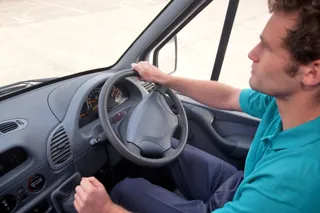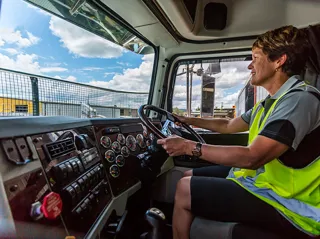The Government is being urged to put safety first in a possible major overhaul of driving licence rules after the authorities launched two consultations.
Ministers want the fleet industry’s views on a raft of ideas, which include allowing drivers to get behind the wheel of a vehicle weighing up to 7.5 tonnes, having only passed their car driving test.
In a snap Fleet News online poll, were divided over widening a car driver’s entitlement to heavy vans and trucks, with more than half (53.4%) of respondents against the idea.
Fleet trade and training body, the Association of Fleet Professionals (AFP), would like to see some safeguards introduced, with some form of additional driver training retained.
AFP director Stewart Lightbody said: “If you’re coming out of a Nissan Micra and somebody gives you the keys to a long wheelbase three-and-a-half-tonne van, that’s a big transition.
“Then you’re going to go straight from the Nissan Micra into a seven-and-a-half-tonne box van with a tail lift and air brakes – they are very different things.
“It’s a very easy solution, but the repercussions are quite significant, and it puts a lot of responsibility back on the employer.”
SAFETY CONCERNS
The Department for Transport (DfT) acknowledges that the removal of the test could see individuals driving heavier vehicles with little or no experience and, when considering that 30% of drivers fail the C1 light goods vehicle (up to 7.5-tonne MAM) test, this may increase the already higher accident rates.
Reversing, observation at junctions and using mirrors when changing direction were the top three reasons for not passing the C1 test, which drivers of these types of vehicles must currently hold.
Analysis of Stats19 figures, which cover all road traffic accidents that resulted in personal injury and were reported to the police within 30 days, alongside usage data for C1 vehicles, suggests that, from 2005 onwards, light goods vehicles (LGVs) have a higher rate of accidents than other trucks per billion vehicle kilometres.
In 2019, C1 vehicles were involved in 23% (982) of accidents involving a goods vehicle weighing more than 3.5t (4,339), while representing only 7% of the total distance travelled for goods vehicles in that weight bracket.
When compared with all goods vehicles, regardless of weight, including lighter vans, C1 vans and trucks represent 6% (982 of 17,808) of accidents.
In a call for evidence, launched this month (August), the Government says it is keen to hear from fleets whether any changes to the C1 licence regime could be introduced to help industry, but without a detrimental impact on road safety.
Adrian Walsh, Driving for Better Business advisor and executive director of RoadSafe, believes some safeguards would be necessary, while continual support for drivers from their employers would be vital, as well as possible restrictions based on age.
“Driver support and experience are hugely valuable,” said Walsh. “You don’t throw them the keys and tell them to get into that wagon. You show them how the wagon works first.”
If C1 entitlement were to be granted with a category B licence, the DfT says this may be used for leisure use, or towards the driver certificate of professional competence (DCPC) if they want to drive commercially.
Drivers who are employed for the commercial carriage of goods would remain in the scope of DCPC rules. It is also considering giving drivers who have a car licence the same entitlements to a minibus (category D1) licence.
A review of DCPC rules, announced in November 2021, has been completed, with ministers yet to announce any changes.
Logistics UK says it will consult with its members before taking a view on possible changes, but road safety would be a critical consideration. Chris Yarsley road freight regulation policy manager at Logistics UK, told Fleet News that “whatever is good for road safety, we’ll take that path”.
ENTITLEMENT TO DRIVE
The C1 licence covers medium-sized vehicles from 3.5-7.5t, plus a trailer of a maximum authorised mass (MAM) of up to 750kg, which amounts to a combined total of 8.25t.
Currently, a category B (car) licence entitles holders to drive vehicles up to 3.5t and alternatively fuelled vehicles up to 4.25t (the latter with five hours of additional training) for commercial carriage of goods.
However, this is also the subject of a separate consultation (see box-out above). Drivers who passed their car test prior to January 1997, also gained entitlement to drive a light lorry or heavy van (C1) without the need for a separate test.
Those drivers retained the right to drive a vehicle up to 8.25t when, thanks to an EU directive, a separate test to obtain C1 entitlement was introduced.
DfT statistics suggest that following the introduction of the new testing regime, the number of C1 vehicles and their mileage has more than halved, down by 58%, from around 2.9 billion miles in 2000, to 1.2bn miles in 2019.
The distance lighter vans travelled over the same period increased by 71%, while HGV mileage has remained relatively flat.
Some of the shift towards lighter vans may be explained by the changes to the licensing regime in 1997. However, the increase in last-mile deliveries will have driven a significant share of the increase.
Yarsley said: “Members have reported particular difficulties in recruiting drivers for vehicles up to 7.5t since the requirement for an additional test was introduced in 1997.”
DRIVER SHORTAGE
The DfT is keen to hear whether the demand for more C1-qualified drivers still exists.
Official statistics reveal 74% more lorry tests were carried out between January and March 2022 compared with pre-pandemic levels.
The DfT figures show there were 26,391 truck tests carried out in Q1 2022, 11,197 more than the 15,194 tests carried out from January to March 2020.
Changes to simplify the process to become an HGV driver to help deal with the driver shortage were introduced by the Government in 2021. These included: allowing the offroad part of the lorry test to be carried out by non-DVSA assessors; allowing drivers to take one test to drive both a rigid and articulated lorry; and removing the need for drivers to do a separate car and trailer test.
DfT and the logistics sector have also now launched a recruitment campaign – Generation Logistics – this month, in an effort to raise industry awareness and attract more young people to the sector.
Phil Roe, president of Logistics UK, which helped develop the campaign, said: “Our research has revealed that 90% of the population has never considered working in our industry, yet it employs more than 2.6 million people.”
He is keen to encourage workers of all ages to investigate a career in logistics, but the campaign is initially focusing on young adults aged 16-24 years, before targeting other groups.
A Generation Logistics online hub highlights the benefits of working in the industry and outlines how logistics roles can meet the priorities of the next generation of workers.
Roe said: “The pandemic shone a light on the logistics industry, underlining the importance of our staff as key workers and the critical role our sector plays in everyday life.
“With that in mind, it’s crucial we do all we can to engage with the next generation right now to encourage them to bring their talents to our industry.
“We are hoping to puncture some of the myths around the sector, and provide a clear, practical pathway for those who want to explore whether a career in logistics could be for them – from truck drivers through to data scientists, robotics engineers and everything in between.”
The call for evidence, which includes an online survey closes on October 28.
























Login to comment
Comments
No comments have been made yet.